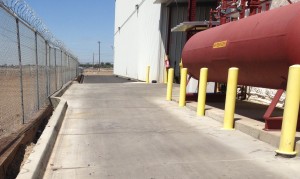Mechanical Integrity 101 | Impact Protection
 One important factor in conducting a quality Mechanical Integrity Inspection is to ensure that the equipment being inspected is adequately protected from accidental impact. Humans are notorious for making mistakes and so, to the extent possible, we must ensure that ammonia refrigeration equipment is adequately protected. Most governing codes and standards for refrigeration systems address this issue to some extent. Here is a quick summary:
One important factor in conducting a quality Mechanical Integrity Inspection is to ensure that the equipment being inspected is adequately protected from accidental impact. Humans are notorious for making mistakes and so, to the extent possible, we must ensure that ammonia refrigeration equipment is adequately protected. Most governing codes and standards for refrigeration systems address this issue to some extent. Here is a quick summary:
- 2013 CMC §1106.5 requires that “refrigeration system and portions thereof shall not be located in an elevator shaft, dumbwaiter shaft, or a shaft having moving objects therein, nor in a location where they will be subject to mechanical damage.“
- ANSI/ASHRAE 15-2013 §9.11.2 requires that “…all such glass columns shall be protected against external damage and properly supported.”
- IIAR Bulletin No. 109 Piping Checklist Item B requires inspectors to verify the following question: “Piping system adequately protected from traffic hazards?“
One of the best and most popular ways to protect equipment is by using barrier posts. What constitutes a compliant barrier post? I am glad you asked. 2012 International Fire Code (IFC) §312 answers this specific question.
2012 IFC §312.2
Guard posts shall comply with all of the following requirements:
- Constructed of steel not less than 4 inches (102 mm) in diameter and concrete filled.
- Spaced not more than 4 feet (1219 mm) between posts on center.
- Set not less than 3 feet (914 mm) deep in a concrete footing of not less than a 15-inch (381 mm) diameter.
- Set with the top of the posts not less than 3 feet (914 mm) above ground.
- Located not less than 3 feet (914 mm) from the protected object.
2012 IFC §312.3
Physical barriers shall be a minimum of 36 inches (914 mm) in height and shall resist a force of 12,000 pounds (53 375 N) applied 36 inches (914 mm) above the adjacent ground surface.

Leave a Reply